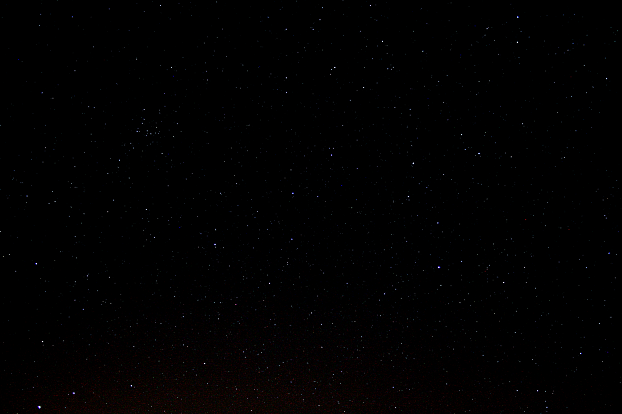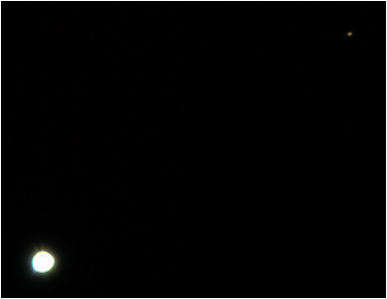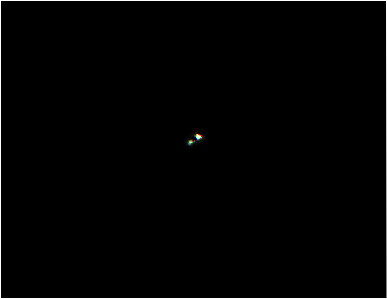

 Leo, the great lion, features in the twelve labours of Herakles (Hercules to the Romans) whose story I recount with an image of his constellation. Suffice it here to say that Herakles was the son of Zeus with a mortal woman, and he was a man of superhuman strength. He was hated by Hera, Zeus' wife, who caused him all sorts of problems during his life. One of these was to put him into a homicidal fit of madness during which he killed his wife and all his children. Overcome with grief, he went to the Oracle at Delphos to ask how he might make true atonement. The Oracle's reply was that he should serve the king of Argolid, Eurystheus, for twelve years and carry out whatever tasks he should be given and, if he survived these, he would be granted immortality. The first of these tasks was to kill the Nemean Lion. This was no ordinary lion; it was the monstrous offspring of equally monstrous Echidna and her son, Orthos, the two-headed hound of Geryon. The lion's skin was impermeable to all weapons so spears and arrows were useless against it. Eventually, Herakles cornered it in a cave and strangled it with his bear hands. Having carried the body back to Eurystheus, he used the lion's own claws to remove the hide and thereafter wore it with the front paws around his neck and the scalp on his head as a helmet. Zeus immortalised the lion in the sky as a memorial to his son's first task.
Leo, the great lion, features in the twelve labours of Herakles (Hercules to the Romans) whose story I recount with an image of his constellation. Suffice it here to say that Herakles was the son of Zeus with a mortal woman, and he was a man of superhuman strength. He was hated by Hera, Zeus' wife, who caused him all sorts of problems during his life. One of these was to put him into a homicidal fit of madness during which he killed his wife and all his children. Overcome with grief, he went to the Oracle at Delphos to ask how he might make true atonement. The Oracle's reply was that he should serve the king of Argolid, Eurystheus, for twelve years and carry out whatever tasks he should be given and, if he survived these, he would be granted immortality. The first of these tasks was to kill the Nemean Lion. This was no ordinary lion; it was the monstrous offspring of equally monstrous Echidna and her son, Orthos, the two-headed hound of Geryon. The lion's skin was impermeable to all weapons so spears and arrows were useless against it. Eventually, Herakles cornered it in a cave and strangled it with his bear hands. Having carried the body back to Eurystheus, he used the lion's own claws to remove the hide and thereafter wore it with the front paws around his neck and the scalp on his head as a helmet. Zeus immortalised the lion in the sky as a memorial to his son's first task.
Leo Minor (I like to call it the "Lion Cub") has no mythological connections, but it appears in my picture so I have indicated its main stars.
Leo is one of the brightest of the Zodiacal constellations and easily identified by the backwards question mark asterism of its main stars. (These are less obvious in my picture than they are in the real sky.) Its primary star, Regulus (α), is within ½° of the ecliptic and so can be occulted by the Moon, quite often, and the planets, very rarely. On 7 July 1959 it was occulted by Venus and a study of this event yielded information about the atmosphere of Venus long before it was visited by space probes. Regulus consists of two binary systems, Regulus itself is a spectroscopic binary, its companion a double that can be resolved with difficulty. Another good double is Algieba (γ); the primary is orange, 180 times as luminous as the Sun, and the secondary is yellow and some 50 times as luminous as the Sun. Many of the stars have names and two are rather long, so I have left the names off my mouseover and I list them separately below. In addition 46-Leonis Minoris is named Praecipua and is the brightest star in the constellation. Strangely Leo Minor has no α star.
The constellation is also the home of several of the local group of galaxies. M65, M66, M95, M96, and M105 all lie close to one another slightly south of the line from α- to θ-leonis. M65 and M66 are only 21 minutes of arc apart and can be seen together in a low-power telescope. They are both spiral galaxies but are not favourably aligned with us. M95 and M96 form another pair and are close to M105. Since these are so close, I have not attempted to show them separately but have indicated the approximate location of M65 & M66, and M95, M96, M108 as groups. In addition there are 14 Messier objects just over the boarder in Coma Berenices, so I have indicated where they are too.
The picture was taken at 23:12 on 8th April 2011 using a Canon 1000D camera with an 18-mm lens at f/4 and a 30-second exposure at ISO 1600. In PhotoImpact, the background glow was removed and the picture reduced to 11% and an unsharp mask applied to compensate for the losses in the reduction.
The major stars and their names.
| Bayer letter | Name | Magnitude |
| α | Regulus | 1.35 |
| β | Denebola | 2.14 |
| γ | Algieba | 2.61 |
| δ | Zosma | 2.56 |
| ε | Ras Elased Australis | 2.98 |
| ζ | Adhafera | 3.44 |
| θ | Chort | 3.34 |
| μ | Ras Elased Borealis | 3.88 |
| ο | Subra | 3.52 |
Both pictures were taken with a DFK 21AF02 camera at prime focus of my LX200. North is at the top.
Regulus is a quadruple star. The primary is a spectroscopic binary consisting of a blue-white main-sequence star with a remarkably short rotation period of 15.9 hours, orbited every 40 days by what is probably a white dwarf. The secondary is a binary of two dwarf, red stars, separated by about 4 arc-seconds. This is great enough that I should have resolved it, but the fainter component is magnitude 13 which is probably too faint to register along with the very bright primary.
Algieba is a binary star of two similar red giants, the fainter star being somewhat hotter and therefore more yellow than the brighter star.
 |
 |
|
| Alpha Leonis, Regulus. Magnitudes 1.4 and 7.7 Separation 177 arc-seconds |
Gamma Leonis, Algeiba. Magnitudes 2.2 and 3.5 Separation 4.4 arc-seconds |